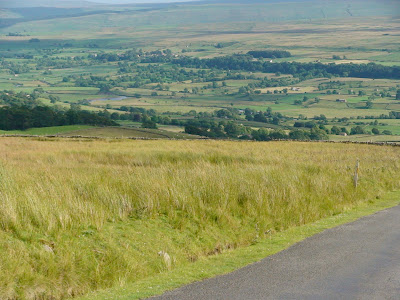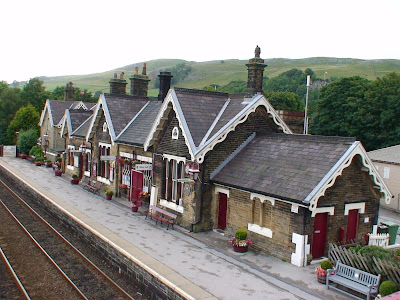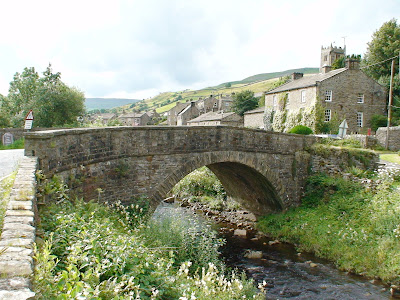Dills in the Dales
DILLS IN THE DALES
To a wanderer on the crowded A-Road system in the United Kingdom, in blinding rain, promotes little joy. The rain was unrelenting and dropping in vast sheets so that I grasped the wheel a little more tightly as the road twisted and turned, a huge black lorry filling all of my mirrors. The motorway, when it came, was therefore also something heaven-sent. I am sure that the sheer speed and volume of the traffic on the motorway set up a horizontal air-flow which forced the rain to dissipate before it reached the ground, because somehow the air seemed clearer! Then again, science was never my forte! But somehow the gloom was lifted. After the rain, the gossamer spray was as light as a veil and our wipers sighed with relief. A couple of days in the Yorkshire Dales would be a welcome break.
We sped past signs which suggested football teams, Manchester, Burnley, Huddersfield and Leeds, and before you could say “Sir Bobby Charlton” we were off the main road and driving in mottled sunshine to Skipton, the self-proclaimed gateway to the Yorkshire dales. Skipton is a bustling market town and indeed when we arrived, the said market stalls smothered the beauty of the main street. It is an attractive town dominated at one end by an ancient cathedral and the drum-tower gates of Skipton castle. The streets are leafy and edged with elegant houses and mansions that have become exclusive schools. Once Skipton was an important port on the Liverpool to Leeds canal, and in the seventeenth century they say the sound of men shovelling dirt never stopped. The diggers were called navigators for the way they dug the canals through the countryside, navvies for short, hence the saying of “working like a navvy”. To us the canals looked quaint and narrow but to the navvies it was surely just a slog. The Liverpool to Leeds canal was one of the very few canals that competed successfully with the railways, right up to the end of WWI, when road transport killed the canal trade. Now the canal narrow-boats carry their tonnage in tourists, and there were many of them, afloat and pedestrian, when we arrived in Skipton. The fighting with the throng certainly hurried our departure. We sought the open road and the beauty of the dales, and in Yorkshire, that combination is never hard to find.
We drove to the town of Settle through countryside lashed with every shade of green, emerald, Sherwood and Lincoln, and had he lived in these parts, Robin Hood would almost certainly have nuanced his clothing. Through the green ran every sort of water course imaginable, from angry rivers of brown, full of wavelets pushing and shoving each other like guests at a Lebanese wedding, to piddles, with brooks, becks, streams and rivulets in-between. Livestock looked prosperous while the grey stone residences looked doughty and ready to shoulder nature’s worst. Winter in these parts is harsh with snow and squalls that chill the bones, and make roads impassable. As I drove, I recalled with pleasure and episode of All Creatures Great and Small when that noble vet, James Herriott, went out to rescue a little lamb in weather that would have tested the polar explorer Amundsen. All Creatures Great and Small was mandatory viewing in our house on a Sunday night. Forget famous Yorkshiremen such as Freddie Trueman and Geoffrey Boycott, Captain Cook, Parky, Dennis Healey and Tony Benn, or symbols like white roses and coal mines; for most people, Yorkshire is James Herriot. Now so much of the dales are simply labelled Herriot Country. How the real James Herriot, Alf Wight, must have chuckled to see his books of warming vet tales turned into such a stupendously successful television series that brought the dales into hundreds of thousands of lounge-rooms and make his nom-de plume synonymous with his county. Indeed while Will Shakespeare strides over all of Great Britain, in terms of “county identification” only the Brontes further south in Yorkshire and Thomas Hardy in Dorset offer any sort of competition to James Herriot on any ‘county affiliation’ scorecard. Later, as we drove over the ruggedly haunting Buttertubs Pass or through Swaledale and Wensleydale, and slaked our thirst in Thirsk, as James and Seigfried might have done, the theme tune to the television series played in my head like a tinkling brook, and somehow the Bitter tasted better.

Yorkshire Buttertubs
We settled in at Settle in a large manor house with a helicopter on the croquet lawn, and after taking tea, as one does in manor houses, we set off to use the last hours of daylight to explore the desolation of the dales. Under scudding clouds and a bullocking wind, we drove to the site of another feat of engineering which, in its own way, is as impressive as the Pyramids or the Eiffel Tower – the great Ribblesdale railway viaduct. From 1870 to 1875 over 5000 men toiled here in the bleakest of landscapes, in a tent and clapboard ‘city’ that apparently looked like something out of the Wild West. Men were literally blown to their deaths from the top of the high arches, while others simply froze to death during the winter construction periods. It is a giant structure of enormous beauty, set among gentle landscape and today still serves as one of the great railway crossings on the Settle to Carlisle line. We returned via the picturesque villages of Ingleton and Clapham by a squiggly little road that ran through fields full of sheep like dandruff on green baize, and dropped in to an old pub beside some sixteenth century cottages in the laughably named little village of Giggleswick. There we had our evening meal and as pub dinners went, it was memorable, but I could not bring myself to have the ‘locally slaughtered lamb’!
The next morning, while my wife slept, I crept down the creaking manor house stairs, rugged up against the blast of Arctic air – and this was high summer I tell you – and found that I had Settle all to myself. I warily walked past dark tiny lanes where I was sure press gangs still lurked, and down to a river looking full of spilled coffee. As always there was the lonely monument to the fallen war dead, many carrying the same name twice or thrice over as an indication of individual family sacrifice. You find them all over Britain and I always feel obliged to stop and read those names, “pals” who went off together, whole villages of volunteers, and left this lovely landscape for the mud and mire of Pozieres or Passchendaele. Many, of course, never came back, leaving women to work the farms and business for long years after the war’s end. I passed a grey stone church with a front garden filled with tombstones, some weary and leaning with years, and some still strong and upright. Even though it was early morning, I thought of the opening line of Thomas Gray’s Elegy in a Country Church Graveyard for it seemed so apt. "The curfew tolls the knell of parting day". In this still hour of the morning, the wind had dropped to a hush, and I was alone beside the graveyard. This beautifully tranquil spot, with a stream alongside and a beckoning hill behind. I looked around for a plodding ploughman, and was saddened when I saw him not.
No trip to Settle is complete without a viewing of its Victorian railway station which, I am sure, even Harry Potter would find enchanting. It has tiny waiting rooms, for the various classes, if you please, a Stationmaster’s office with those wonderful ticket windows where you bought those strong cardboard tickets, and not to forget, a Porter’s room. A waist-coated porter with his baggage trolley, was so long a fixture at railway stations, helping ladies with their suitcases and men with their bags. The whole station is haloed by flower boxes full of geraniums and petunias and bedecked with those railway seats that simply tell you “Settle”. On the opposite platform is a smaller version, and in-between there are two sets of steel tracks that fade into one in the distance. Here, surely, Auden’s Night Mail headed for the border, bringing the cheque and the postal order, shovelling its white steam over its shoulder. When I stood on the tiny footbridge that connected the two platforms and sniffed to smell the coal-smoke, as in my youth, my nose failed to cooperate, and nostalgia remained solely visual.

York's Settle Station
I am sure that God has many favourite places on this planet but as the wonderfully descriptive author Bill Bryson has said “I don’t know for sure if Malhamdale is the finest place there is until I have died and seen heaven (Assuming they let me at least have a glance) but until that day comes, it will certainly do”. We too thought that God probably holidayed in Malhamdale from time to time for as we abseiled in to the dale by way of the twisting, rope-wide, road from Settle, even the drizzle did not dampen its beauty. We stopped a number of times – not least to pat a Border Collie that ran miles beside our car – but also just to gaze in awe. Bryson was right, we surmised, it was simply stunning in its beauty. Towering over the tiny village is the Malhamdale Cove, a limestone amphitheatre from a time millions of years ago when the sea dwelt here. Now it is a haunt for picnicers, ramblers and rock-climbers or just a place to look at in awe and admire its grandure. We drove away and said to each other, “Yes, good call, Bill”. We had noted the name of a real estate agent, and said we would look him up on the net when we got home!
But then we had tiny doubts when later we gazed at the ruins of Bolton Abbey, across the raging River Wharfe, and again at Burnsall with its cricket field beside a Norman bridge, and Grassington with its triangular village square and its old parish pump, and again at Kettlewell, the site for the movie Calender Girls, even though there was not a bared breast in sight. How could Bill, and indeed God, choose in an area of so much beauty? Later we saw Muker in Swaledale and the question arose again. We kept asking ourselves “How could he choose?” for we could have settled happily in a dozen places. I sat down at The Farmers Arms and ordered an Old Perculiar ale and pondered the conundrum. Perhaps the only solution was a stint at Kirkby Malham, hoping that like Bill, I might find the secret to his blissful contentment and his acute observations that make his books such a delight to read.

York's Muker Bridge
After a night at a wonderfully snug pub in Hawes, we left the green and stony dales early the next morning. Ours had been a brush-stroke visit and there was a need to return many more times to fill in the gaps, or even to paint afresh. We had been absolute dills to only give the dales a day or two for it is a place of such beauty and tempered tranquillity, that you cannot come away but rested, in mind as well as body.
Winfred Peppinck/wandering freditor is the Tales of the Travelling Editor for Wandering Educators.






















Tom Voigts
Having been to both London and Scotland (all over) the article made me want to schedule an extended trip to the UK. The small towns and rural atmosphere are the real draw for me. Thanks for the wonderful article. Tom